Design decisions
Language Server Protocol, or the lack of
The plugin is not using LSP and there is no plan to use it in the future. I'll try to explain the reasoning behind that decision here.
First, plain text editors (VSCode, Textmate, VIM, etc.) and IDE (Jetbrains editors) are two very different categories. Text editors need additional mechanisms to be able to create a nice developer experience, including adding semantic to the sources, adding referencing of symbols for nice navigation, documentation, etc., caching and indexing for fast response.
On the other side, an IDE - as the name implies (Integrated) - already has these behaviors
embedded in the software. With regard to Jetbrains, many man-hours have been invested through
years of development into these exact problems of indexing, referencing, etc. They have their own
structures (PSIElement) that you must follow if you want to use the full power of the IDE.
If you do so, you get a lot of functionalities for free. You won't find many IntelliJ plugins that
are using LSP for - IMO - that exact reason. It would be more integration work if you externalize
the parser or the indexing.
Of course, the drawback of not using LSP is that creating a functional plugin needs more work.
The goal of the plugin is also to work out of the box, and be cross-platform (this is the strength of the JVM). The idea is to try to keep things at the JVM level, and thus work at much as possible at the source level. In a second pass, to improve results, we also use information from the compiled typed trees (the cmt files) - but it is optional.
Finally, these decisions give us the ability to provide multiple languages implementations easily: the plugin works at ReasonML and OCaml source code, and embed Dune, ML4, MLG, MLL, MLY syntax.
Language
The plugin is entirely written in Java (only version 8 is supported for now). Kotlin was not selected for two reasons: Java might be easier for people who want to contribute occasionally, and Kotlin workflow is much slower than Java.
Project organisation
The project is built using the gradle IntelliJ plugin.
The build.gradle can be found at the root of the project directory.
Each version of the IntelliJ is developed in its own branch (ex: 191-2019.1, 192-2019.2, etc.). The main branch is the version just below the latest version (ex: if 2020.1 is the latest released, the master branch contains the 2019.3 version).
You'll find a jps-plugin subproject in the sources.
It was initially created to integrate bucklescript or dune compilation with the normal build process of Idea,
see external build process.
That work has been canceled for lack of time, but jps-plugin is still used for shared elements.
Structure of the sources is:
bs,esy,dunecontains source code of the corresponding compilershintscontains source related to Rincewind processidecontains all editor functionalitieslangcontains parser code, PSI definitions, stubs, etc. for the different languages
Modules
When developing a plugin, you must be aware of the differences between the different products of the Jetbrains family.
Not every feature are available to the editors (for ex: the JS functionality is not present in IntelliJ community). Moreover, modules are only exposed in the IntelliJ products.
There are 2 important concepts:
- project: a project is a container for a module. It can have different modules of different types. It doesn't know about the sources.
- module: a module contains the root sources. They have a type that define what language they accept.
For non-IntelliJ products, the project and the module is a 1-to-1 relation. Even if the module is not exposed, it is still present and must be used to find the root of the sources.
Plugin functionalities are defined in a xml file that uses extension points of the IDE to register classes. there are different xml files:
plugin.xml: the main entry, contains all entries common to every product. It also references the other xml files.java-deps.xml: depends oncom.intellij.modules.javaand is only loaded in IntelliJ products;js-deps.xml: special post activities when plugin is used in a javascript editor (ex: webstorm)
Lexer / Parser
PsiElement
To know more about Program Structure Interface, go to Jetbrains SDK doc.
Not only every element of a source code must be described as a PSIElement, but also any element that could be used in one of the IDE functionality. For example, all files are also PSI elements: this is needed to get functionalities like navigation, refactoring, etc.
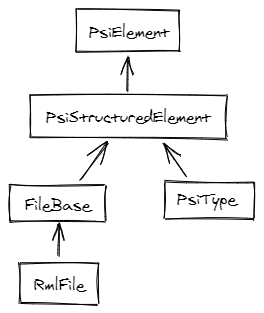
Everything is a
PSIElement, even the files
Every parser must create a tree of PSIElement.
You will see three different types in the code: ORTokenElementType, ORCompositeElementType, and types that inherit from
IStubElementType.

ORprefix means OCaml/ReasonML and is used for shared classes between these two syntaxes
The ORTokenElementType are classes generated by the lexer. They are atomic tokens and are always represented as leafs
in the AST.
The ORCompositeElementType are classes generated by the parser, by composing tokens from the lexer or other composite
elements. They will always be nodes in the AST.
The IStubElementType are an extended version of a composite element: they will mostly be used in a top level structure
that needs indexing.
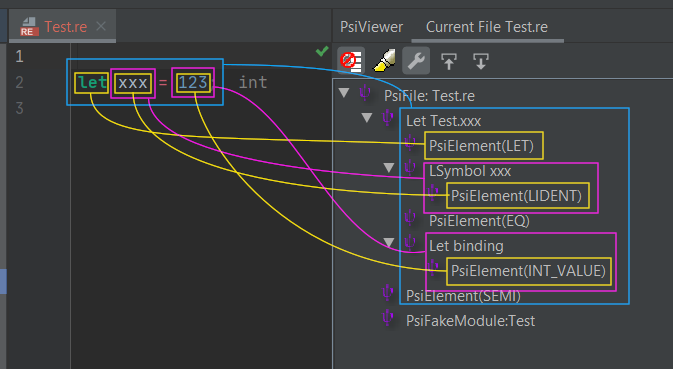
In yellow, the
ORTokenElementTypeproduced by the lexer, in purple theORCompositeElementTypeand in blue theIStubElementType(in that case, aPsiLetStubElementType).
Lexer
The lexer is automatically generated from the JFlex
file com\reason\lang\ReasonML.flex.
If you want to update the generated code, you can
ctrl+shift+gin the file.
The lexer is used a lot in a performance critical path and must contain the minimum of logic to be the most efficient possible.
ReasonML.flex is used for the ReasonML language and the OCaml language.
Dune.flex (in the same directory) is the lexer used for Dune files.
Parser
The ReasonML/OCaml parser is entirely coded manually, it doesn't use a Grammar-Kit grammar.
The first versions of the parser were coded using Grammar-Kit, but we reconsidered that option due to many problems. The recovery mechanism was very difficult to use, and debuging a grammar kit generated parser was not satisfying. Handling two different languages was also challenging. Plus we wanted to add some semantic and context during the parsing to help desambiguate the syntax (unfortunately, that point is not really used with the new parser neither).
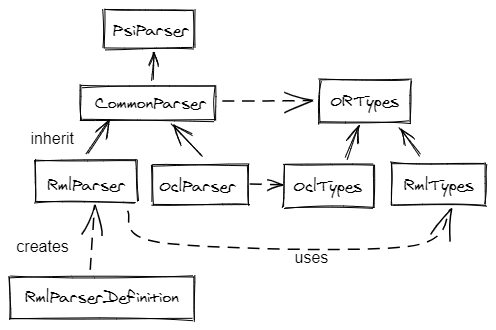
Generated types are defined in an abstract common class and implemented in two different subclasses. Same for the parser, each syntax has its own parser that must produce the same AST of
PsiElement.
Recovery mechanism is very important, as you can see in the following screenshot. Even if the module expression
is incorrect and not ended, we have correctly identified the next expression as a let (see
the AST in the PsiViewer window). Even the module is identified as a composite module node, but without the
module binding node.
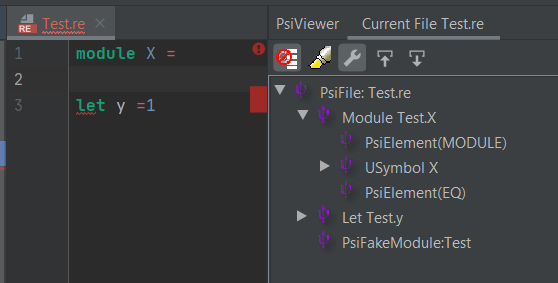
Recovery anchors are top level expressions, like
let,type,switch, etc.
Also note, that even if it's possible, there are no errors produced by the parser: syntax errors are delegated to the compilers.
Indexing
Before we can resolve symbols to their corresponding definition, we need to index them. Only stub elements are indexed. Again, for everything you want to know about stubs, go to the Jetbrains SDK doc.
Stub elements are the serialized versions of the corresponding PsiElement. All the stubs are found
in com.reason.lang.core.stub and you can see what properties for each stub are saved on disk.
It's important to use the stub instead of the real component whenever possible, to skip heavy computations, and to avoid IntelliJ to load and parse the real file. For ex, this is how we use stub:
public String getQualifiedName() {
PsiModuleStub stub = getGreenStub();
if (stub != null) {
// use serialized version of the PsiElement
return stub.getQualifiedName();
}
// else, normal - time consuming - operation
...
}
In com.reason.lang.core.stub.type, you can find the definition of IStubElementType for each of the composite
types that must be serialized (ex: PsiLetStubElementType, PsiModuleStubElementType, etc). Remember these
classes are used in ORTypes and are the equivalent of a ORCompositeElementType class. The IStubElementType is where you find the code
for serialization and deserialization of a stub/composite element.
A stub element can be referenced in different indexes. For example,
PsiLetis referenced by name and by qualified name.
All the index are found in com.reason.ide.search.index.
com.reason.ide.search.index.IndexKeys contains the constants that define the indexes you'll see when
using the indices viewer. These constants are used in the stub element types when serializing/deserializing elements.
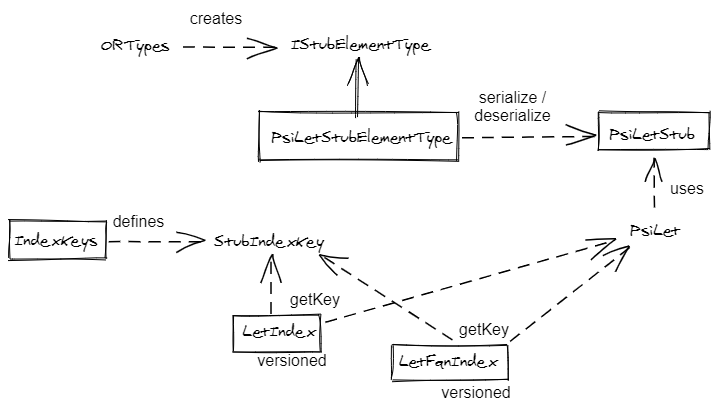
Relations between stubs, keys and indexes
Virtual namespaces / files
Bucklescript has a directive to automatically generate files with a namespace.
namespace: true | "name"
This is problematic when indexing the files at the source level, because the namespace only exist at the generated code, and indexing files is different from indexing inner modules of a file. Also, we want to use the same indexes for the inner modules and for the files.
To solve these problems, we add a fake element at the end of the file. This
element implements the PsiModule interface, like any other module, and can be indexed
with the same lifecycle.
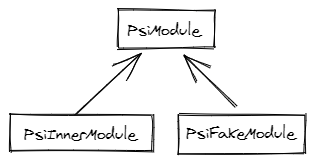
This is a 'fake' element, because there is no token associated with it.
An empty file always have a PSI element, the fake element that represents the file itself
If there is a virtual namespace, the qualified name of the PsiFakeModule will contain it.
Resolving
For advanced functionalities in the editor, a symbol must be resolved to its definition.
Only PsiLowerSymbol and PsiUpperSymbol can be resolved. As you can see in the next screenshot,
every token that may need a resolution must be wrapped with one of these composite element.
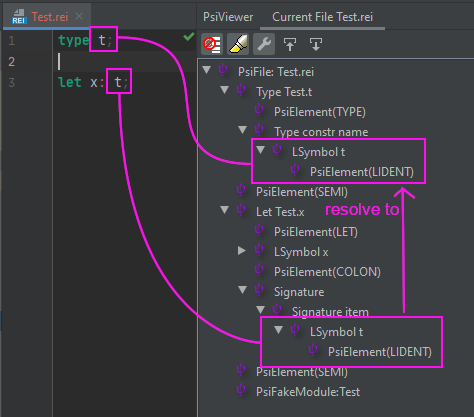
In that screenshot,
PsiElement(LIDENT)is the token returned by the lexer (thetitself), andLSymbolis thePsiLowerSymbolwrapped around that token in order to add resolution.
There are two classes associated with them: PsiLowerSymbolReference and PsiUpperSymbolReference.
This is where resolution happens.
When resolving a symbol, the first thing is to build a list of potential paths for qualified name.
Ex: file Foo.re
open M1;
module M2 = {
include M3;
x()
}
When user control-click on x, we need to resolve (find) its definition: we start at x and move backward
up until the start of the file, and build a list of paths. Potential paths for this exemple are:
M3, Foo.M3, M2, Foo.M2, M1, pervasives.
The class that extract path is QNameFinder.
Then, when we have a list of potential qualified names, we use the indices to retrieve the
corresponding PsiElement from that key. All the code that get Psi from indices is found
in the Psifinder class.
Type inference
Type inference is the signatures you see next to the code, and it can't be selected:
That information is retrieved from the
.cmtfiles. These files contain the serialized content of a typed tree after compilation by OCaml.
When a file is saved, it is compiled and that creates a cmt file. A process read that file
, extract type information and store them in a cache in the PsiFile representing the source code
(see SignatureProvider.SIGNATURE_CONTEXT).
We use an additional tool for that: Rincewind.
Rincewind is a very lightweight implementation of a cmt information extractor. It is downloaded automatically by the plugin when the corresponding OCaml version is known.
It returns a list of signatures, one per line. ex:
Va|1.4,1.5|i|int
Va|2.4,2.5|f|float